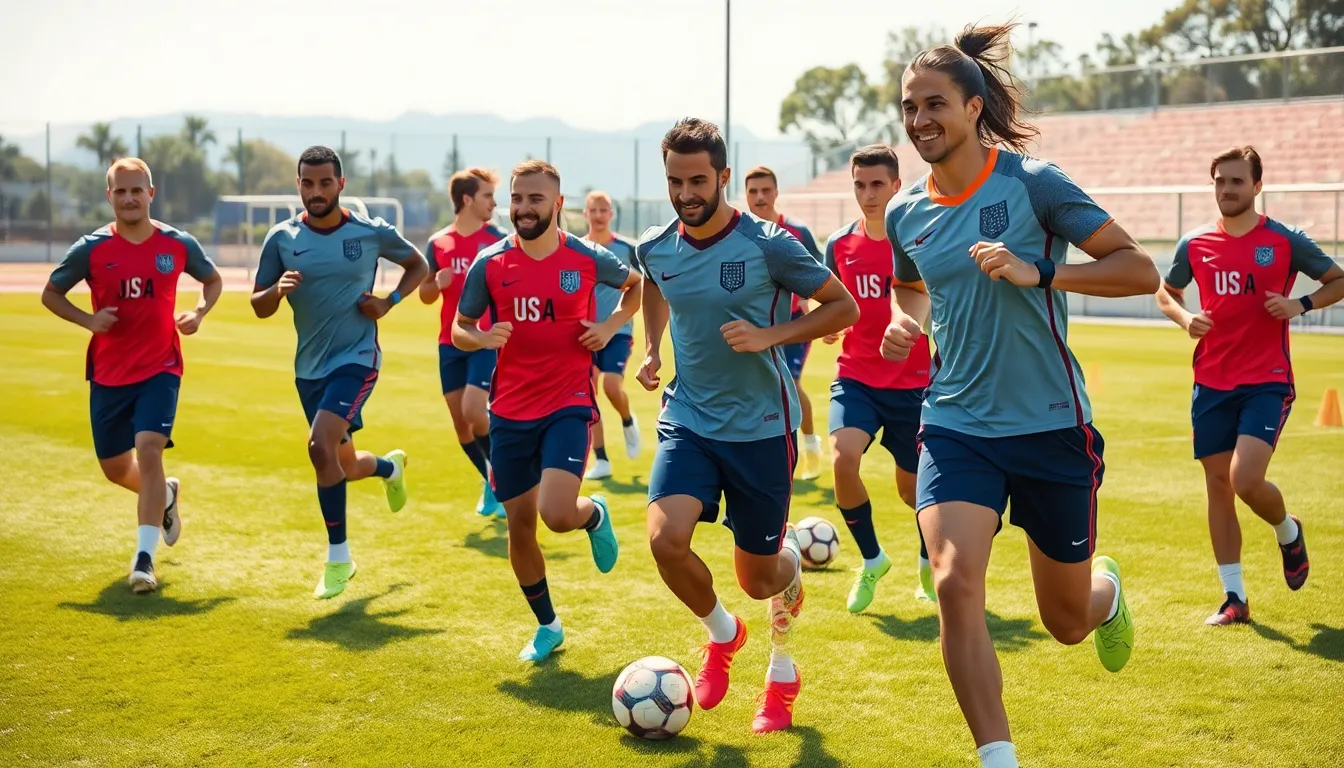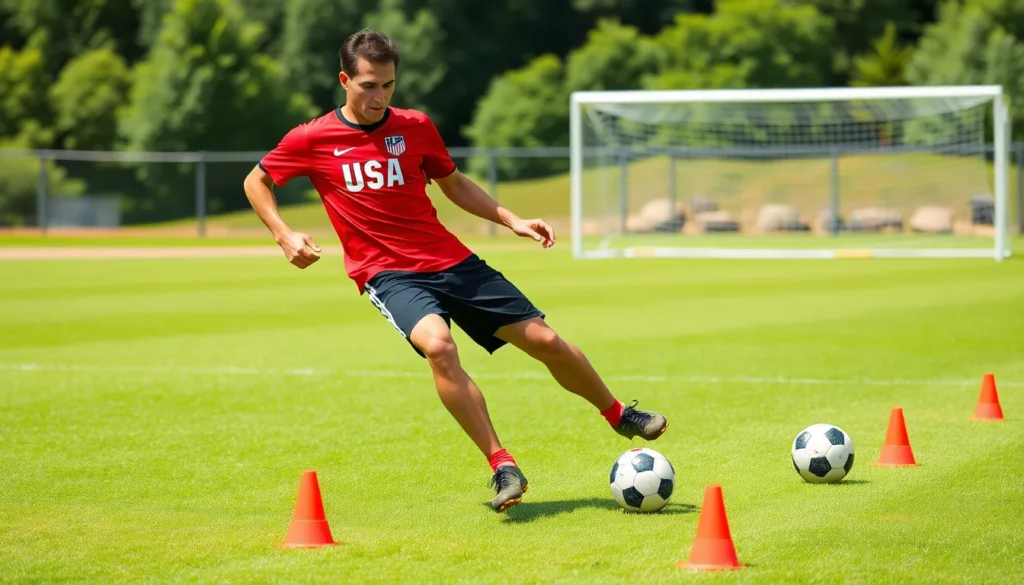Soccer isn’t just about fancy footwork and scoring goals; it’s a high-octane sport that demands peak physical fitness. Whether players are sprinting down the field or dodging defenders, they need strength, speed, and stamina. Enter soccer fitness training—the secret sauce that turns average Joes into soccer superstars.
Table of Contents
ToggleImportance Of Soccer Fitness Training
Soccer fitness training enhances players’ performance on the field. Conditioning develops the strength needed to execute powerful shots and robust tackles. Speed training allows athletes to outrun opponents, making quick sprints crucial during matches. Stamina builds endurance, enabling players to maintain high energy levels throughout the game.
Incorporating agility drills into training improves footwork and reaction times. Flexibility exercises prevent injuries and promote quicker recovery. Furthermore, strength training provides core stability, enhancing balance during play.
Research shows that players focusing on fitness maintain optimal performance levels for longer durations. Statistics indicate that fit players are less prone to injuries, minimizing time away from practices and games. This approach leads to safer play and higher overall team morale.
Soccer fitness training fosters mental resilience. Athletes who maintain peak physical condition exhibit greater confidence and focus on the pitch. Enhanced mental toughness allows players to better handle game pressure.
Conditioning sessions often include interval training, promoting explosive movements that replicate game scenarios. These sessions teach athletes how to conserve energy while maximizing effort during critical moments. Ultimately, a holistic fitness regime ensures comprehensive development for soccer players. Prioritizing fitness in training transforms average players into exceptional competitors on the field.
Key Components Of Soccer Fitness

Soccer fitness consists of several critical components that enhance overall player performance.
Endurance Training
Endurance training builds stamina, allowing athletes to maintain energy levels throughout matches. Longer training sessions improve cardiovascular health, enabling consistent effort and quicker recovery during play. Incorporating exercises like running, cycling, and interval workouts ensures players develop the necessary fitness to endure intense game situations. Players often engage in varied intensity levels during these sessions, mimicking match conditions and aiding in long-term performance improvements.
Strength Training
Strength training focuses on enhancing muscle power and stability. By incorporating weightlifting and bodyweight exercises, players develop the physical strength required for powerful shots and tackles. Resistance training forms the core of this program, targeting major muscle groups critical in soccer. Regular strength workouts help improve overall balance and coordination, directly translating into better on-field performance. Players may perform exercises like squats, lunges, and deadlifts to build a solid foundation.
Speed And Agility Training
Speed and agility training enhances players’ quickness and ability to change direction rapidly. Short sprints, cone drills, and ladder exercises train muscles to react instantly, crucial for outperforming opponents. Improving footwork fosters better control, allowing players to navigate tight spaces effectively. By focusing on explosive movements, athletes increase their top speed while decreasing response time. Incorporating these drills into training regimens streamlines player performance in high-pressure situations on the pitch.
Developing A Soccer Fitness Training Program
Developing a soccer fitness training program starts with understanding the unique demands of the sport. Players must focus on specific fitness components, including endurance, strength, and agility.
Assessing Fitness Levels
Assessing fitness levels provides a clear starting point for athletes. Coaches can conduct fitness tests such as the beep test for endurance, vertical jump assessment for strength, and sprint tests for speed. By recording results, they establish benchmarks for improvement. It’s crucial to evaluate players regularly to gauge progress and adjust training accordingly. Tracking improvements over time motivates players and fosters accountability. Incorporating baseline assessments makes individual training more tailored to each player’s needs.
Creating A Balanced Routine
Creating a balanced routine involves integrating various training components. Incorporate endurance training through running or cycling sessions, complemented by strength workouts using bodyweight exercises or weights. Add agility drills like cone sprints and ladder exercises to improve footwork and quickness. Scheduling these elements strategically throughout the week ensures players receive well-rounded fitness training. Focus on flexibility with stretches or yoga sessions to enhance recovery. By maintaining this balance, players develop comprehensive skills essential for optimal performance on the field.
Tips For Effective Training
Effective soccer fitness training requires a focused approach. It incorporates key elements like nutrition and recovery to optimize performance.
Nutrition Considerations
Nutrition plays a vital role in a player’s fitness. Incorporating a balanced diet rich in carbohydrates, proteins, and healthy fats fuels energy levels. Hydration should never be overlooked; drinking water before, during, and after training helps maintain optimal performance. Including fruits and vegetables provides essential vitamins and minerals necessary for recovery and overall health. Timing meals around training sessions enhances energy availability. For instance, consuming a carbohydrate-rich snack within 30 minutes post-training supports muscle recovery. Emphasizing lean proteins can help rebuild muscle tissues effectively, contributing to strength development.
Recovery Techniques
Recovery techniques are crucial for maintaining performance and avoiding injuries. Prioritizing rest days within training routines allows the body to heal and adapt. Effective methods include stretching, foam rolling, and massage to relieve muscle tension. Additionally, getting sufficient sleep rejuvenates the body and enhances cognitive function during gameplay. Engaging in active recovery, like light jogging or swimming, can promote circulation and aid muscle repair. Cold therapy, such as ice baths, reduces inflammation after intense training sessions. Incorporating these techniques not only enhances recovery but also prepares players for the next training day, ensuring consistent performance improvements.
Fitness training is a game-changer for soccer players aiming to elevate their performance. By focusing on strength speed and stamina athletes can significantly enhance their skills on the field. A well-rounded training program not only improves physical capabilities but also fosters mental resilience which is crucial during high-pressure situations.
Incorporating endurance training agility drills and strength exercises ensures players remain injury-free while maximizing their potential. Nutrition and recovery play vital roles in this process allowing athletes to maintain peak performance throughout the season.
Ultimately investing in comprehensive soccer fitness training transforms players into formidable competitors and contributes to overall team success.




